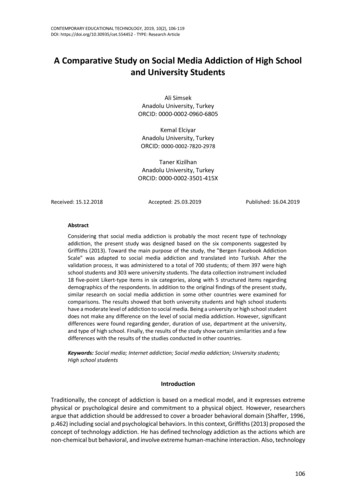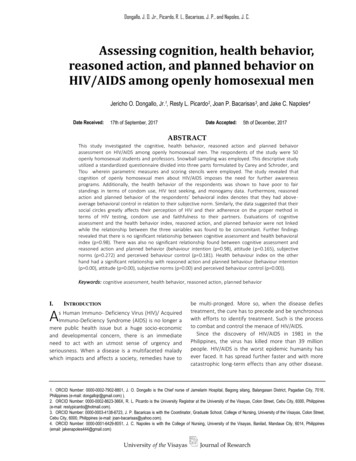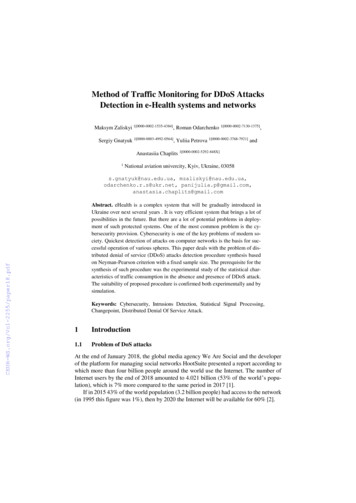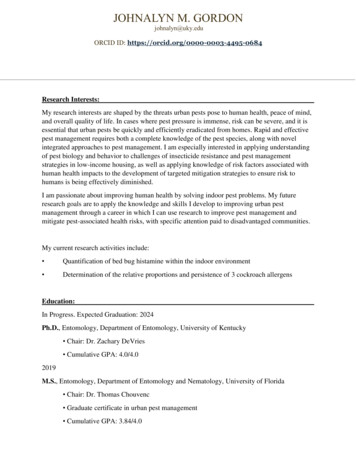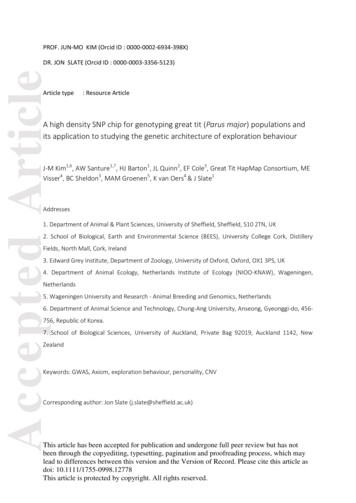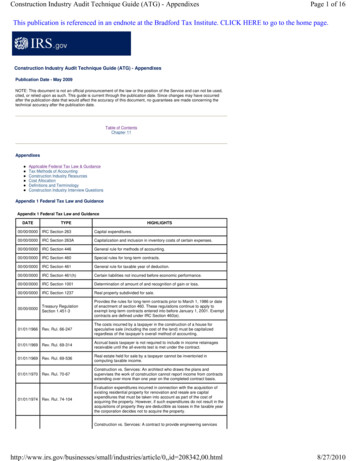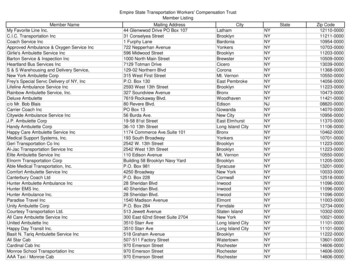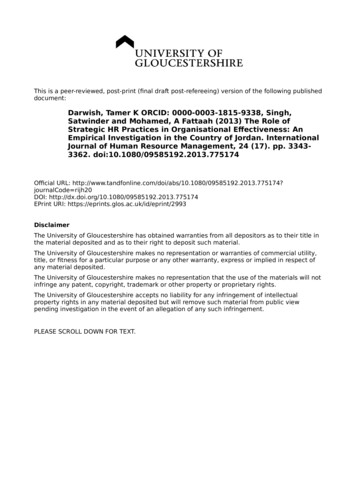
Transcription
This is a peer-reviewed, post-print (final draft post-refereeing) version of the following publisheddocument:Darwish, Tamer K ORCID: 0000-0003-1815-9338, Singh,Satwinder and Mohamed, A Fattaah (2013) The Role ofStrategic HR Practices in Organisational Effectiveness: AnEmpirical Investigation in the Country of Jordan. InternationalJournal of Human Resource Management, 24 (17). pp. 33433362. doi:10.1080/09585192.2013.775174Official URL: 2.2013.775174?journalCode rijh20DOI: nt URI: rThe University of Gloucestershire has obtained warranties from all depositors as to their title inthe material deposited and as to their right to deposit such material.The University of Gloucestershire makes no representation or warranties of commercial utility,title, or fitness for a particular purpose or any other warranty, express or implied in respect ofany material deposited.The University of Gloucestershire makes no representation that the use of the materials will notinfringe any patent, copyright, trademark or other property or proprietary rights.The University of Gloucestershire accepts no liability for any infringement of intellectualproperty rights in any material deposited but will remove such material from public viewpending investigation in the event of an allegation of any such infringement.PLEASE SCROLL DOWN FOR TEXT.
This is a peer-reviewed, post-print (final draft post-refereeing) version of the followingpublished document:Darwish, Tamer K and Singh,Satwinder and Mohamed, A Fattaah (2013). The Roleof Strategic HR Practices in OrganisationalEffectiveness: An Empirical Investigation in theCountry of Jordan. The International journal ofHuman Resource Management, 24 (17), 3343-3362.ISSN 0958-5192Published in The International Journal of Human Resource Management, andavailable online 5192.2013.775174?journalCode rijh20We recommend you cite the published (post-print) version.The URL for the published version is laimerThe University of Gloucestershire has obtained warranties from all depositors as to their titlein the material deposited and as to their right to deposit such material.The University of Gloucestershire makes no representation or warranties of commercialutility, title, or fitness for a particular purpose or any other warranty, express or implied inrespect of any material deposited.The University of Gloucestershire makes no representation that the use of the materials willnot infringe any patent, copyright, trademark or other property or proprietary rights.The University of Gloucestershire accepts no liability for any infringement of intellectualproperty rights in any material deposited but will remove such material from public viewpending investigation in the event of an allegation of any such infringement.PLEASE SCROLL DOWN FOR TEXT
The International Journal of Human Resource ManagementThe Role of Strategic HR Practices in Organisational Effectiveness:An Empirical Investigation in the Country of JordanTamer K Darwish, Satwinder Singh, and A. Fattaah MohamedAbstractThis study responds to the call of researchers, and is conducted in a non-Western context in thecountry of Jordan. The study contributes to our understanding of HR practices’ impact onorganisational effectiveness. The empirical analysis is based on theoretical prepositions thatmotivated employees through good HR practices stay longer and contribute positively to theoverall financial performance of organisations. Rigorous statistical testing of the data on thepopulation of financial firms shows that careful recruitment and selection, training, and internalcareer opportunities have a positive impact on reducing employee turnover. Training, inparticular, is found to have a strong positive impact on financial performance measured byROA and ROE. Furthermore, the findings provide strong support for the direct approach inSHRM-performance research that a group of best HR practices will continuously and directlygenerate superior performance. Despite such compelling arguments, however, we did not findevidence to support the notion that a bundle of HR practices impact better on financialperformance than individual HR practices. It is possible that the optimal configuration may notonly be contingent on national context, but due to the sector and the specific characteristics ofthe firm.Keywords: HR practices; organisational effectiveness; SHRM-performance link; factoranalysis; hierarchical regression.1.IntroductionThe field of strategic HRM (SHRM) has attracted a great deal of attention during thepast decade owing to its potential impact on the functioning of the organisations. Thisattention reflects the growing importance of human capital in terms of gainingcompetitive advantage and thus enhancing organisational performance (OP). There isnow an evolving belief that, if organisations wish to survive and compete in the presentday knowledge-based global economy, they have to acquire and develop world-classhuman resource competencies and the practices necessary for managing such (Pfeffer,1994, 1998; Schuler and Jackson, 1999; Khandekar and Sharma, 2005; Moideenkutty,Al-Lamki and Rama Murthy, 2011). This belief has subsequently led to research1
The International Journal of Human Resource Managementsurrounding the link between SHRM and OP. A number of researchers who haveconducted studies on this research stream have confirmed the positive impact of SHRMon OP (see, for example, Huselid, 1995; MacDuffie, 1995; Delery and Doty, 1996;Wright and Boswell, 2002; Moideenkutty et al., 2011; Razouk, 2011). However, thereis also a group of researchers who have argued that the results of the SHRM-OP link arenot encouraging, and that they are, in fact, ambiguous (Paauwe and Boselie, 2005;Guest, 1997; Paauwe, 2009). It is also being increasingly argued that additional studiesin different contexts are required in order to obtain a broader view on the SHRM-OPlink (see, for example, Gerhart, 2005; Guest, 2011; Ericksen and Dyer, 2005; Wright etal., 2005; Chand and Katou, 2007). Thus far, most studies in this arena have beencarried out in the Western context. Accordingly, the present study aims to fill thisapparent gap by conducting an in-depth analysis of HR practices in Jordan. The studyassumes added importance in that it is conducted in the context of an all-importantfinancial sector, and further accounts for the population of firms in this sector.2.Theoretical Background and HypothesesThis section first highlights the controversies surrounding the core issues concerningHR practices in the SHRM-OP link, as well as the measurement of OP itself. We thenreview the literature related to empirical work conducted in this research stream.Discussion here is divided under two sub-headings: Direct Relationship between SHRMand Performance, and Indirect Relationship between SHRM and Performance. It isconsidered that this scheme should help us to define the conceptual issues in a clearermanner and, in the process, highlighting the difficulties in the topic under investigation,thus leading to the derivation of testable hypotheses in a clearer manner.2.1The HR practices in the SHRM-OP linkThe majority of the empirical work that has been conducted in the SHRM-Performancelink has given attention to sixteen best practices, later consolidated into seven proposedby Pfeffer (1994, 1998). It is argued that the greater use of these practices (training andskill development, promotion from within, participation and employment, informationsharing, and others) would lead to increased productivity and profitability, and therebyassist organisations in achieving competitive advantage. Although this has been apopular classification, researchers have nevertheless also used different measures to2
The International Journal of Human Resource Managementconduct SHRM-performance link studies, and there remains, as yet, no generalconsensus as to which combination of HR practices would enhance organisationalperformance (Wright and Gardner, 2003; Beltran-Martin et al., 2008; Paauwe, 2009;Guest, 1997, 2011; Singh et al., 2012). Even if researchers adopted the same practices,the underlying meaning of such may ultimately be different1.2.2Organisational PerformanceAs is the case with the SHRM-OP link, as yet, there is no consensus amongstresearchers on the measurement of OP; thus, it remains an imprecise and looselydefined construct—not only in the field of HR but in other fields as well (Rogers andWright, 1998). For instance, Scott (1977, p. 63), in his review of the measures oforganisational effectiveness, concludes that, ‘after reviewing a good deal of theliterature on organisational effectiveness and its determinants, I have reached theconclusion that this topic is one about which we know less and less’. Organisationalperformance can be defined in terms of HR-related outcomes (turnover, job satisfaction,commitment, and others) or organisational outcomes (productivity, quality, service,efficiencies, and others) (Dyer and Reeves, 1995). Moreover, it can also be defined interms of financial indicators—Return on Assets (ROA) or Return on Equity (ROE) orcapital market outcomes: market share, stock price, and growth. Notably, the term‘performance’ is more specific than ‘effectiveness’, thus researchers usually refer to theterm ‘effectiveness’ when they consider multiple outcomes of performance in theirstudies. Dyer and Reeves (1995) propose that HR strategies would most likely directlyaffect the HR-related outcomes, followed by organisational, financial and marketoutcomes. The logic behind this is that HR practices have their most direct impact onemployee behaviours and attitudes which, for example, will subsequently result in a lowturnover and high satisfaction, which in turn, has the capacity to generate highorganisational and financial outcomes. Some authors (see, for example, Paauwe andBoselie, 2005; Paauwe, 2009) emphasise the use of the multi-dimensional concept oforganisational performance which can more reflect the effectiveness of the companies.1This has led to a plea by some authors for a specific theory on HRM in the first place (Paauwe andBoselie, 2005; Paauwe, 2009; Guest, 1997, 2011).3
The International Journal of Human Resource ManagementHowever, in the final analysis, it seems there is no firm agreement amongst researcherson this issue2.2.3Empirical work on SHRM-Performance linkSince the emergence of the SHRM-Performance debate, two broad research streamshave emerged to examine the relationship between strategic HRM and performance.The first one follows a direct approach between individual HR practices and/or a bundleof HR practices and performance (Chand and Katou, 2007). The second research streamhas focused on the indirect relationship between individuals’ HR practices and/or abundle of HR practices and that of organisational performance (Wright and Gardner,2003).2.4Direct relationship between SHRM and PerformanceStudies on the direct SHRM-Performance link suggest that specific HR practices canultimately enhance organisational performance (Pfeffer, 1994; MacDuffie, 1995;Huselid, 1995; Delaney and Huselid, 1996; Guest, 1997; Guest et al., 2003). Thesespecific HR practices helping organisations to achieve better results have been termedas ‘best practices’ (Pfeffer, 1994), ‘high-performance work system (HPWS)’ (Way,2002; Beltran-Martin, 2008; Guthrie et al., 2009), ‘high-involvement practices’ (Woodand Menezes, 2008) or ‘high commitment practices’ (Wood, 1996).Researchers have also examined the impact of a bundle or system of HR practices onperformance on the presumption that they are of the appropriate level of analysis toexamine the impact of organisation-level performances (Delaney and Huselid, 1996). Itis stated that a bundle (the internal or horizontal fit) of practices should generate greatereffects owing to the whole being greater than the sum of its parts. For instance, in orderto recruit and select good employees without having to train them, or to otherwise trainand develop them without giving them the authority to make decisions, will producefew effects; implementing the three practices together, on the other hand, wouldproduce greater effects (Wall and Wood, 2005). This is in contrast to individual HRpractices which, in isolation, can produce only a limited amount of competitiveadvantage (Barney, 1995). In totality, however, there is again no agreement amongst2In fact there is a call here as well for a better theory on performance itself from some scholars (Paauweand Boselie, 2005; Guest, 2011).4
The International Journal of Human Resource Managementresearchers on what these practices should be, or even on the number of practices thatcan enhance organisational performance (Dyer and Revees, 1995; Wright and Gardner,2003; Guest, 2011). The only agreement seems to be that such practices can lead tobetter performance for all types of organisations.2.5Indirect relationship between SHRM and PerformanceThere are a group of scholars who have argued that, whether individual or in a bundle,HR practices do not directly affect organisational performance (Katou and Budhwar,2006). HR practices, at best, only impact various mediator variables which, in turn, willimpact organisational performance. It was held that HR practices would most likelydirectly affect the HR-related outcomes such as employee turnover, followed byorganisational, financial and market outcomes (Dyer and Reeves, 1995). The logicbehind such a proportion is that HR practices have their most direct impact onbehavioural outcomes which, for example, will subsequently result in a low turnover,which in turn, has the capacity to generate high organisational and financial outcomes.This can be termed as the ‘black box’ issue in the context of SHRM-Performanceresearch. As a result, some researchers have begun to consider and search inside the‘black box’ in an attempt to understand which HR practices could mostly impactorganisational performance (see, for example, Huselid, 1995; Huselid et al., 1997; Way,2002; Ahmed & Schroeder, 2003; Katou & Budhwar, 2006; Beltran-Martin, 2008;Wood and Menezes, 2008). Different mediating variables have been used byresearchers to find an effective mechanism in which HRM can best impact onorganisational performance such as employee turnover, employee productivity,employee satisfaction, knowledge management, and organisational culture. Thisaddresses the call of some researchers (Dyer and Reeves, 1995; Wright and Gardner,2003; Guest, 1997, 2011) for the exploration of new theoretical frameworks withdifferent mediating variables. However, owing to there being no established methodavailable to researchers to follow in order to determine which HR practices could(indirectly) impact organisational performance, little attention has thus far been directedtowards exploring this aspect of research further in this direction (Wright and Gardner,2003).2.6Hypotheses5
The International Journal of Human Resource ManagementThe literature, as described above, may seem inconclusive, but it does point to certaindirections and research questions, which can then be translated into testable hypotheses.These hypotheses also echo the general theme that emerges from the (glossy) HRliterature of organisations—most of which now claim to view their employees as assetsto be optimally used and not as costs to be minimised. The drivers leading to thisoptimal use are HR practices, which markedly help motivate and retain employeeswithin an organisation. This results in reduced employee turnover and enhancedfinancial performance. Importantly, such themes from the literature review and thecorporate world can be translated into the following four testable hypotheses:H1: HR practices, i.e. recruitment and selection, training, internal career opportunities,performance appraisal, extrinsic incentives and reward, and intrinsic incentives andrewards, will all reduce employee turnover.H2: HR practices, as stated in H1, will positively relate to financial performance. Thepositive financial performance can be captured in increased Return on Assets (ROA)and Return on Equity (ROE).H3: Employee turnover will mediate the relationship between HR practices andfinancial performance.H4: There will be a positive relationship between a bundle of HR practices and that offinancial performance.3.Data, Variables and Methods3.1Data and SampleThe target population of this study is the financial sector of Jordan. Jordan, a country ofsix million inhabitants, occupies a strategic location within the Middle East. Althoughthe country gained its independence from Great Britain in 1946, British heritagecontinues to appear in the Jordanian educational, economic and legal systems, and theEnglish language is still used widely in the business and academic fields (Al-Shaikh,2003). In recent years, Jordan has opened its markets to world trade and investment,and is fast becoming a credible player in global commerce. Jordan’s stock exchange has6
The International Journal of Human Resource Managementbecome one of the fastest growing open avenues for foreign investors. This growinginternational integration is exposing the country to both regional and internationalcompetition and risks (Al-Shammari and Hussein, 2008), which have subsequentlycoaxed companies into becoming increasingly competitive; however, given its limitednatural resources, the onus is falling on the services sector, which contributes to over75% to the country’s national income (World Fact Book, 2009). Importantly, thefinancial sector is one of the largest and best-developed service sectors in the country,and is currently witnessing a great deal of deregulation, which is attracting privateinvestment from within the country as well as overseas. This sector had been largelyinsulated from the recent financial crisis owing to it’s as-yet limited exposure tooverseas capital markets. This, however, is changing fast, which became evident duringthe course of the research for this paper, when the authors spoke to a large number ofHR managers responsible for financial issues.A count of all the firms operating in the financial sector revealed a population of 104firms in banking, insurance, real estate, brokerage and other financial services. Thesefirms are all listed on Amman Stock Exchange (ASE). Thus, it was decided that all thefirms in the population would be approached for the purpose of data collection.Notably, we required two types of data for the study: the first set comprising primarydata related to the HRM operations of these firms; the second set related to financialoperations. A detailed questionnaire was drafted with the objective to gather theprimary data. Following almost all the work conducted in HRM-performance link, thetargeted respondents in the present study were HR directors. All the 104 firms werecontacted in person, of which 99 agreed to participate in the survey. Questionnaireswere delivered by hand and collected in person. Cross-checks reveal data to beconsistent and reliable. The matching financial data from profit and loss accounts andbalance sheets of 99 firms were collected from the financial statements from ASE.Fortunately, government policies and regulations require all the listed companies toreport the financial data in a consistent manner, which makes the inter-firmcomparisons meaningful and unbiased.3.2Construction of HR practices7
The International Journal of Human Resource ManagementWe were required to build scales to measure HR practices and employee turnover forthe first half of the study. We developed these measures based on existing SHRMliterature. The major part of our deliberation on HR practices has been developed basedon the work of Delery and Doty (1996) and Pfeffer, (1998), with the former havingidentified a set of HR practices of strategic import. In turn, their work is notably basedon the theoretical and empirical work of Miles and Snow (1984), Osterman (1987),Kerr and Slocum (1987), and Sonnenfeld and Peiperl (1988). In this study, the HRpractices scale covered 5 areas of HRM: recruitment and selection; training; internalcareer opportunities; appraisals; and incentives and rewards. These common practicesare most likely to be found in most organisations with a HR department or the basic HRfunctions. In addition, our measures on HR practices are different from most of theempirical work conducted in SHRM-Performance link (more details on our measures ofHR practices can be found in Singh et al., 2012). For instance, prior work which hasinvestigated such a relationship under terms such as ‘high-performance work system’,‘high-involvement practices’ or ‘high commitment practices’ has mostly employed onesingle item to reflect each practice which in our opinion is not enough to measure theconstruct or the practices of HRM. Such measures of HR practices would make thepractical implementation for HR directors and professionals a complex process. In thecase of the present work, each measure on HR practices has been reflected by severalitems as a result of the factor analysis. Our results show that each set of items can makeup a composite measure, and also indicate that they are correlated and each one can bemeasuring broad phenomena. Such measures can be easier to understand, making thepractical implementation and the theoretical development of HRM issues lessproblematic.The recruitment and selection comprised questions on formal and informalqualifications and personal characteristics that companies considered in appointing anemployee to a middle-grade general management job. This question offered 12 items.The training questions related to the most applicable methods (of training) had 4 items;internal career opportunities—referred to as the main criteria of individual or groupperformance used in assessing cases for promotion—had 6 items. Importantly, allquestions were measured on a Likert scale ranging from 1 ‘not applicable’ to 5 ‘alwaysapplicable’. The performance appraisal question inquired into how frequently and bywhat methods appraisals were conducted, as well as how feedback was dispensed.8
The International Journal of Human Resource ManagementFinally, in the incentives and rewards section, three questions were asked: the first onequeried how the salary differentials were explained to employees (4 items); the secondasked questions on policies adopted in order to retain key staff (6 items); and the thirdquestioned the benefits for an employee working for the company (4 items)? All ofthese questions and their items were measured on a Likert scale ranging from 1 ‘notimportant’ to 5 ‘very important’. As noted above, more details of these measures on HRpractices can be found in Singh et al., (2012).3.3Outcome variablesEmployee Turnover: this is an important outcome variable. The inability to retaincompetent and skilled employees has been identified as a barrier to organisations’success (Holt, 1993). Most studies (e.g., Arthur, 1994; Huselid, 1995; Wood and DeMenezes, 2008) conducted in the context of the HRM-Performance link have taken intoconsideration employee turnover as a vital outcome and an important indicator oforganisational performance. Following the work of Arthur (1994), Huselid (1995), andWay (2002), employee turnover rate is measured through the use of a simple and directquestion concerning the percentage of total employees that voluntarily leave thecompany each year.3.4Financial performanceReturn on Assets (ROA) and Return on Equity (ROE) are two essential outcomevariables that have been considered in the literature as indicators of firm financialperformance (see, for example, Keats, 1988; Snell and Youndt, 1995; Delery and Doty,1996). ROA has been used as a measure of efficiency and resource-exploitation inorganisations (Keats, 1988; Snell and Youndt, 1995). ROE, in contrast, represents theeventual measure of the strength of any financial organisation (Earle and Mendelson,1991). Retaining these variables for our study, data were obtained from the ASEdatabase. The study also follows the cross-sectional design adopted by other authors(such as Arthur, 1994; MacDuffie, 1995; Delaney and Huselid, 1996; Bae and Lawler,2000; Way, 2002; Wright et al., 2005) wherein both predictors and outcome variablesare measured on one occasion only. The measures of ROA and ROE for this study werethe year-end measures for 2007.3.5Control variables9
The International Journal of Human Resource ManagementIt is essential to include control variables in the study owing to their possibleassociation with dependent variables. The literature review shows that firm size and ageare commonly utilised control variables in the studies on HRM-Performance link, andcan cause significant variations in the impacts of HRM practices on organisationalperformance. Firm size, in particular, has been found to be an important control variable(see, for example, Collins and Clark, 2003). In this study, we employ firm size and firmage as a control variable, measured respectively in natural logs (see also Kimberly,1976) by the number of employees in each company, and the number of year thecompany has been in operation.3.6MethodsIn order to test the listed hypotheses, the following approaches were adopted. First ofall, exploratory factor analysis was conducted for all HRM practices in order tosummarise and group together the data that was correlated. Additionally, in order to testthe validity of the variables under consideration, confirmatory factor analysis wascarried out. The descriptive analysis of data (Table 1 and Table 2) includes the mean,standard deviation, skewness and kurtosis, and zero-order correlations. Hierarchicalregression analysis was adopted for modelling the data.Before conducting the regression analysis, data was screened and tested for themultivariate assumptions. Outliers test was conducted and results revealed no extremecases. Furthermore, the results of normality test revealed that the variables’ skewnessand kurtosis values lie within the acceptable limit of ranges, except for in relation tofirm size and firm age, both of which were then transformed into logs. The relationshipsbetween variables were homoscedastic; they all met the normality assumption(Tabachnick and Fidell, 2007). Tests also revealed the absence of multicollinearitybetween the variables.3.7Exploratory factor analysis of HR practicesWe performed principal component factor analysis with Varimax rotation for all the HRpractices. The outcomes generated only one factor for each variable with the exceptionof incentives and rewards. Two factors were generated for this variable, whichexplained 41.65% of the total variance. The first factor is more commonly associatedwith extrinsic incentives and rewards, such as pay increase and valuable fringe benefits;10
The International Journal of Human Resource Managementthe second factor, in contrast, is more keenly associated with intrinsic incentives andrewards, such as friendly and supportive work-environment. This is consistent with thetheoretical structure proposed by DeCenzo and Robbins (2005). The results confirm arobust and comprehensive structure of incentives and rewards; therefore, the first factorwas labelled as ‘extrinsic incentives and rewards’, whilst the second factor is ‘intrinsicincentives and rewards’.3.8Convergent and discriminant validity of HR practicesConfirmatory factor analysis was conducted, which provided three main indicators forassessing the convergent validity in the form of factor loadings, average varianceextracted (AVE), and reliability of the construct (Hair et al., 2010). The results showthat the factor loadings of each construct’ indicators are significant, ranging from 0.56–0.90, thus demonstrating a strong association between constructs and their factors.Furthermore, the results indicate that AVE values were higher than the threshold valueof 0.50, therefore demonstrating adequate convergence of the constructs. Finally, theresults of the Cronbach’s Alpha test indicate that the scales satisfy the reliabilitycriterion, with values ranging from .61 to .93. Taken together, the results of factorloadings, AVE, and reliability tests provide sufficient confirmation of the convergentvalidity. Moreover, we compared the square roots of AVE values with the constructs’correlations from where the results showed that the squared roots of the AVE valueswere higher than any correlation of the HRM practices’ constructs, indicating anacceptable level of discriminant validity (Fornell and Larcker, 1981).4.Results4.1Descriptive resultsTable 1 reports the means, standard deviations, skewness and kurtosis of all variables.Table 2 presents the results of zero-order correlations of all variables underconsideration. It is instructive to note at the very outset that the relationship betweenHR practices is significant. Additionally, recruitment and selection, training, internalcareer opportunities and extrinsic incentives and rewards are also significantly relatedto ROA and ROE, and negatively with employee turnover. Performance appraisals,however, is negatively and significantly related to financial indicators. Expectedly,ROA and ROE are significantly correlated.11
The International Journal of Human Resource ManagementTABLES 1 AND 2 ABOUT HERE4.2Test of the first hypothesisThis first hypothesis concerns the direct relationship between HR practices andemployee turnover. We conducted hierarchical multiple regression through multiplesteps (Bae and Lawler, 2000). As shown in Table 3, the value of R2 for this model ishighly significant (R2 .73, F 30.92, p .001), which means that the predictorsaccount for 73% of the
The Role of Strategic HR Practices in Organisational Effectiveness: An Empirical Investigation in the Country of Jordan Tamer K Darwish, Satwinder Singh, and A. Fattaah Mohamed Abstract This study responds to the call of researchers, and is conducted in a non-Western context in the country of Jordan.
